

In our recently released report, Declining births and lower demand: Charting the future of public school enrollment in D.C., we examined the changes to the two main drivers of enrollment – (1) births in D.C., and (2) the preference for families to live in D.C. and choose its public schools. Because of declines in both drivers, that report analyzes several enrollment scenarios that public schools in D.C. may experience in future years, and projects that despite a previous decade of steady growth, enrollment in D.C.’s public schools may remain stagnant at pre-pandemic levels or may continue to decline.
In addition to analyzing District-wide trends, we also wanted to investigate both drivers in terms of race and demographic trends in the city. This analysis shows that in recent years, the share of students who are Black enrolled in D.C.’s public schools has declined across all grade bands – due in part to fewer births to mothers who are Black and weaker preferences for pre-kindergarten during the pandemic.1
Other publications in this series:
Enrollment trends by race and grade band
Changes in enrollment patterns vary by race. While most students who attend D.C.’s public schools (DCPS and public charter) are Black, the percentage of students who are Black has declined between school years 2013-14 and 2021-22 in all grades. The largest drop — 10 percentage points — is in pre-kindergarten and high school grade bands. Across the same time, the percentage of students who are white has increased, with the most pronounced growth seen in early childhood grades: an increase of 8 percentage points. The share of students who are Latino has stayed constant across grade bands.
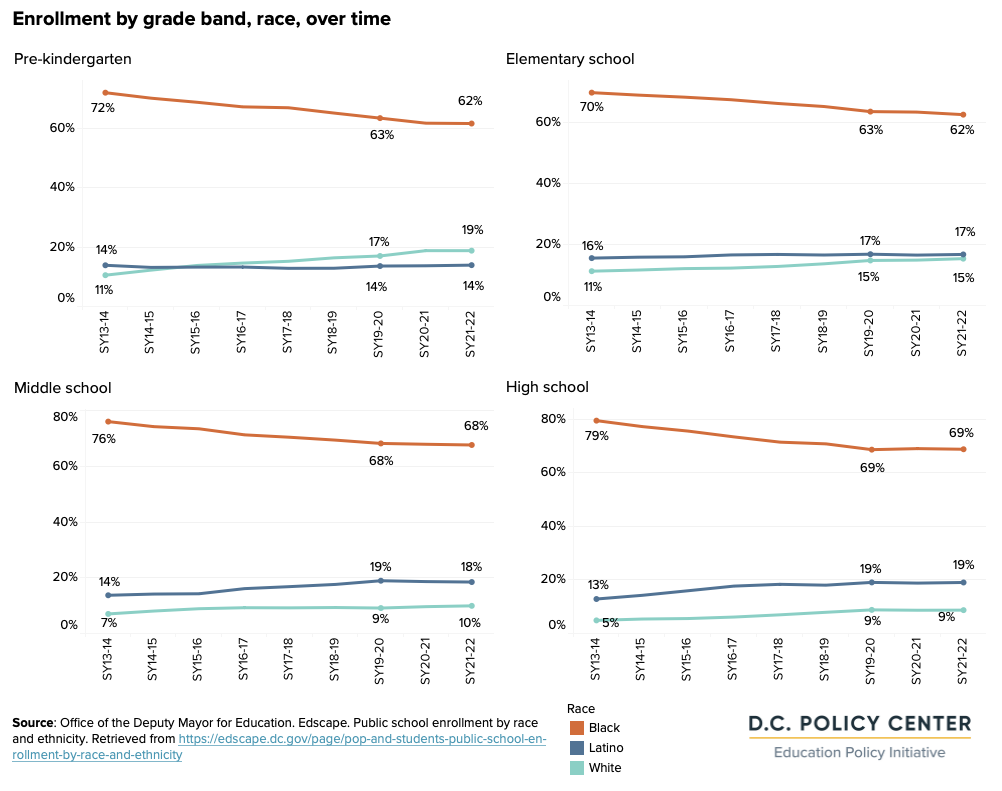

To better understand the underlying factors that lead to these shifts, we examine changes in birth trends and changes in enrollment preferences by race.
Birth and fertility trends by race and ethnicity
The number of births in D.C. has been decreasing since a peak in 2016, but this trend varies by race and ethnicity of mothers. Births to white mothers increased from 2007 to a peak in 2016 at 3,116 births, before beginning to plateau at 34 percent of overall births. Births to both Black and Latina mothers have seen declines during the same time, but at different rates.
More recently, from 2016 to 2019, the total number of births in D.C. dropped by 9 percent or 984 births. This decline is largely driven by the declining births to Black mothers. The number of total births for Latina and white mothers changed by 2 percent or less – births to Latino mothers decreased by 71 births, while births to white mothers increased by 15. Births to Black mothers declined much faster, by 654 births or 13 percent.
Some of this decrease is likely explained by shifting demographics in D.C. The total Black population in D.C. declined by 10 percentage points from 2007 to 2019, while the Black population of the most likely childbearing age (ages 25-34) declined by 4 percentage points.2 Overall, the decline in the number of births outpaced these demographic shifts in part because of lower fertility rates and in part because of outmigration.3 In recent years, there has been a net outmigration for residents who are Black.4
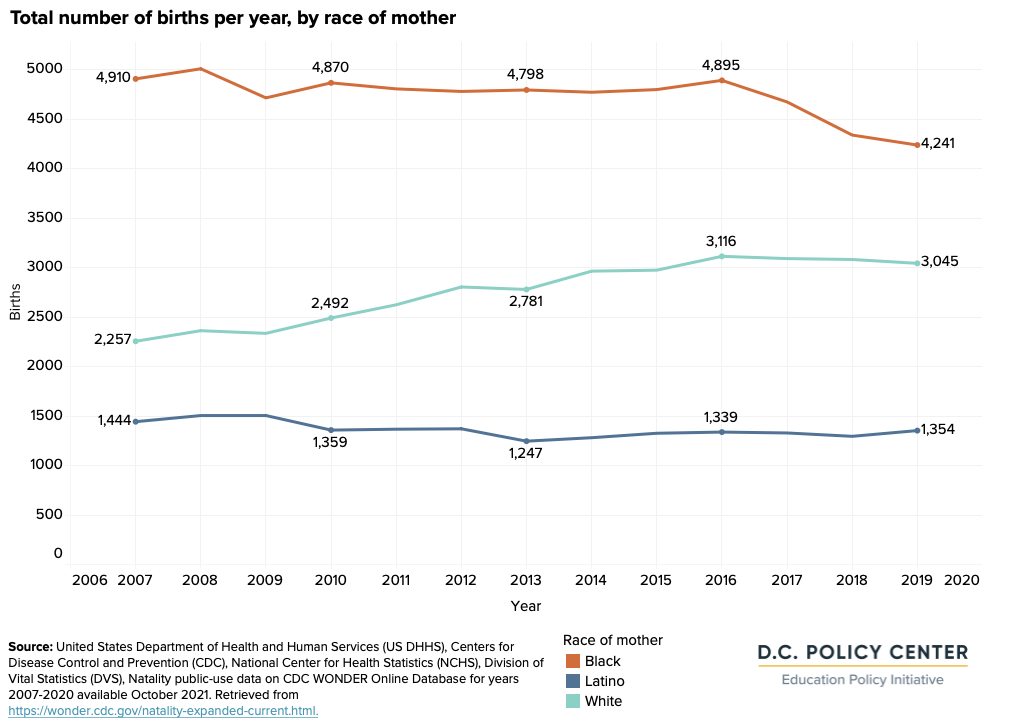

One of the reasons why there are fewer overall births in D.C. is that there are fewer births per woman. The fertility rate5, or the number of births per 1,000 women ages 15-44, has declined across all races since 2007. Across the District, the total fertility rate has declined by 22 percent from 2007 to 2020. As of 2019 (the most recent year of available data), the largest change was seen for Black mothers, at a 13 percent decrease in fertility rate. The fertility rate declined the least for white mothers (less than 1 percent), and rates for Latina mothers declined by 6 percent.
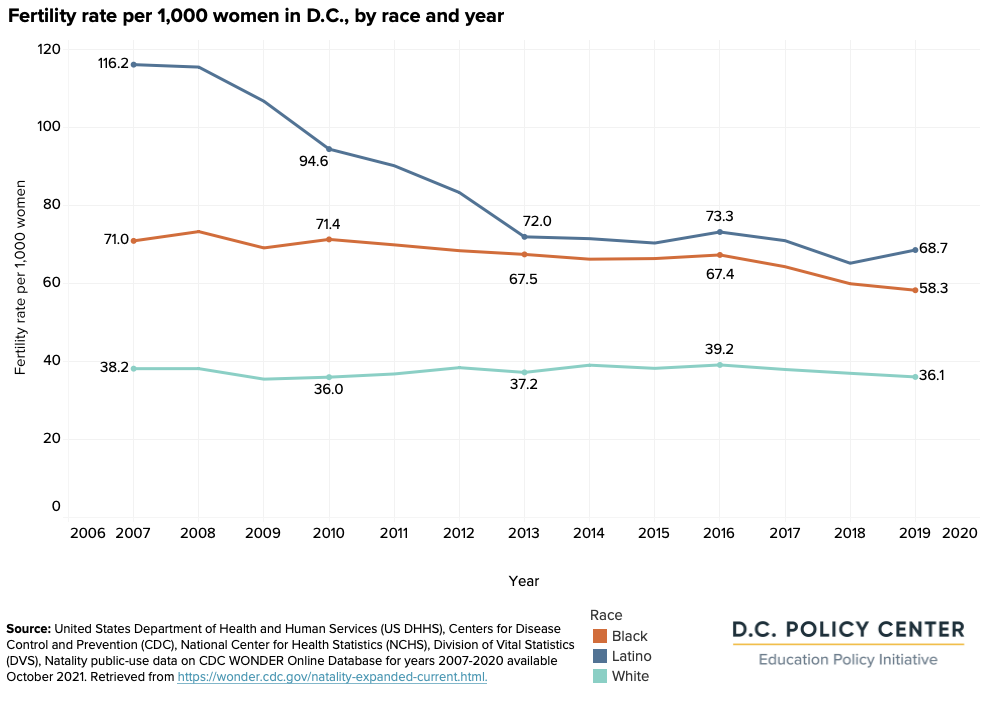

Cohort retention trends by race and ethnicity
Actual enrollment numbers are determined by how many families live in D.C. and choose its public schools. One way to quantify these choices is through a measure called the cohort retention ratio, which compares the number of students enrolled in a given grade to the number of babies born in D.C. for the corresponding birth year.
Total enrollment in non-compulsory early childhood grades (PK3 and PK4) declined due to COVID-19. The cohort retention ratio for children who are Black in pre-kindergarten declined from 84 percent in school year 2019-20 to 77 percent in school year 2020-21. In other words, out of every 100 babies born in D.C. who are Black, 84 enrolled in a PK3 or PK4 program three and four years later in school year 2019-20. This number declined to 77 out of every 100 in school year 2020-21. The pre-kindergarten cohort retention ratio for children who are Latino declined by 5 percentage points during the same pandemic school years while the ratio for children who are white stayed constant at 36 percent.
The larger decline in the cohort retention ratio could correlate with Black communities being more sensitive to the impacts of COVID or being more likely to seek out other options during non-compulsory pre-kindergarten grades. (Cohort retention ratios for the first compulsory grade of kindergarten declined by a smaller amount for children who are Black). The inverse could be true for high school, when virtual schooling offered opportunities that many students and families who are Black enjoyed and therefore were more likely to enroll or stay enrolled in D.C.’s public school options.6 While the retention ratio for pre-kindergarten students who are Black declined by 7 percentage points from school year 2019-20 to school year 2020-21, the retention ratio declined by just 3 percentage points for grade 12 students who are Black.
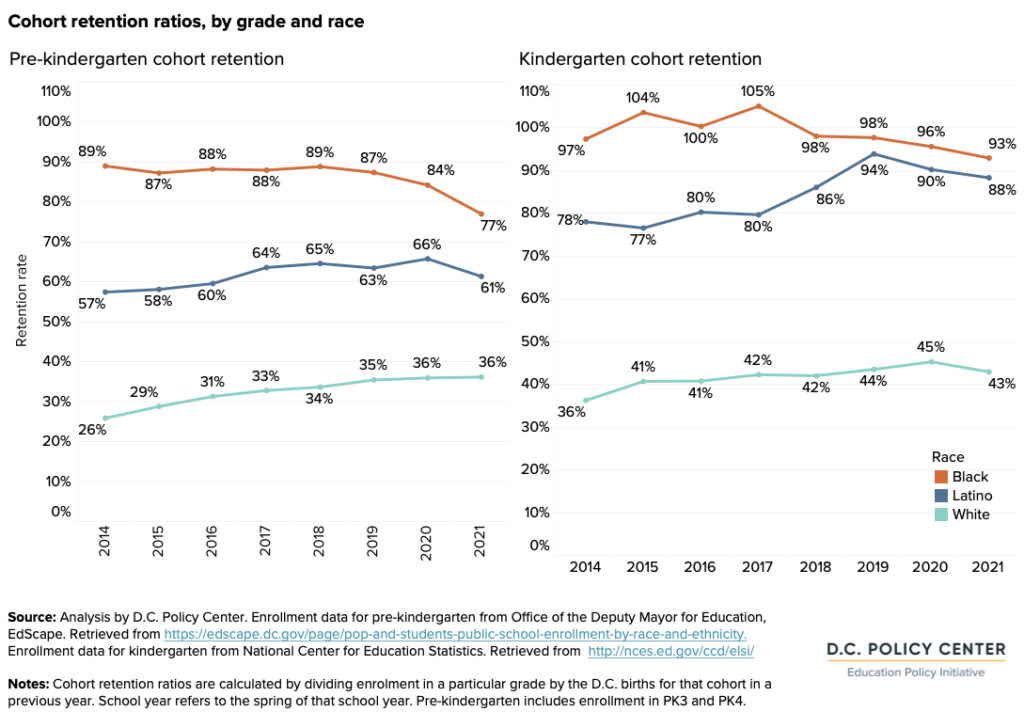

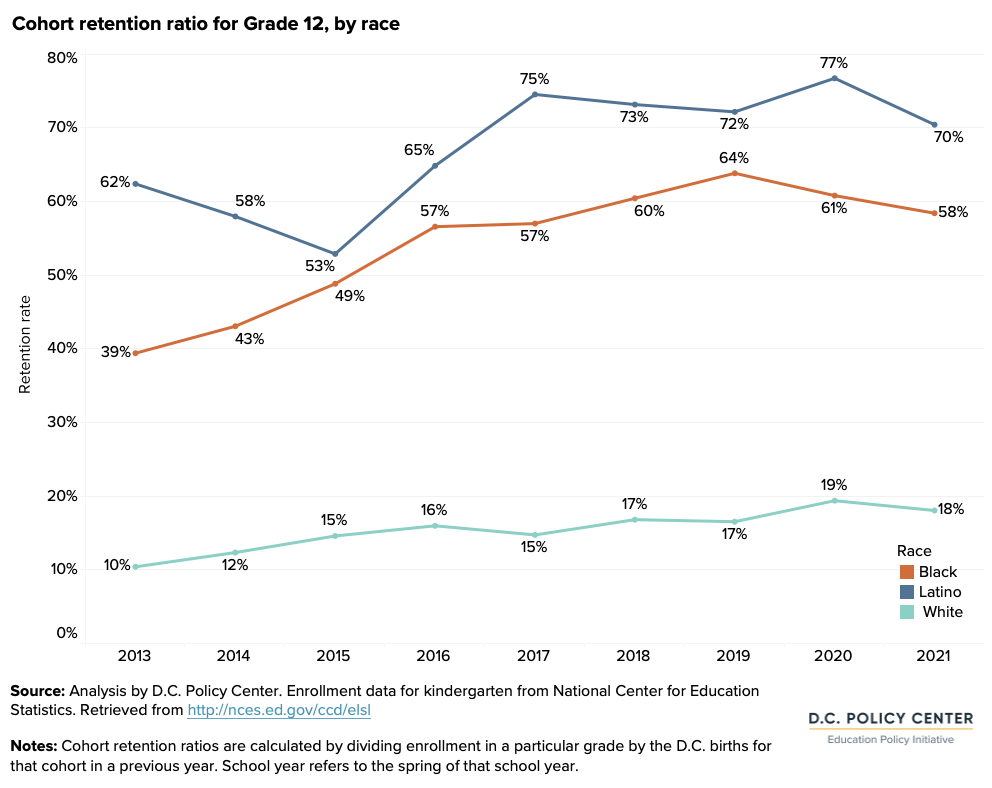

Implications
Enrollment in D.C.’s public schools is likely to decline over the next five years, especially in younger grades due to fewer births and a lower share of children staying in D.C. and choosing its public schools.7 There are also important enrollment shifts occurring by race and ethnicity. The percentage of students who are Black has declined in all grades bands since at least 2013-14 (when data is available). The percentage of students enrolled who are Latino and white has increased or remained stable during the same time. Underlying this trend, there have been larger declines in the number of babies born who are Black and the cohort retention ratio for pre-kindergarten for children who are Black, compared to the same Latino and white cohorts who have not experienced as much change in births and retention. These shifts could have implications for the composition of students in future years.
Endnotes
- Women of childbearing age and births to mothers are common metrics used by demographers. Please note that these metrics are not inclusive of all childbearing people.
- Steven Ruggles, Sarah Flood, Ronald Goeken, Megan Schouweiler and Matthew Sobek. IPUMS USA: Version 12.0 [Race, Hispanic origin, and age – 2007, 2019]. Minneapolis, MN: IPUMS, 2022. https://doi.org/10.18128/D010.V12.0
- While there are not data available for births by race of mother for years 2020 and 2021, the overall number births in D.C. continued to decline for these years.
- U.S. Census 2020 ACS 1-Year PUMS with Experimental Weights
- The fertility rate is a common metric used by demographers. Note that it is not inclusive of all birthing people.
- Coffin, C. & Rubin, J. 2022. State of D.C. Schools 2020-21. D.C. Policy Center. Retrieved from https://www.dcpolicycenter.org/publications/state-of-dc-schools-20-21/
- Coffin, C. and Rubin, J. 2022. Declining births and lower demand: Charting the future of public school enrollment in D.C. D.C. Policy Center. Retrieved from https://www.dcpolicycenter.org/publications/enrollment-decline/
